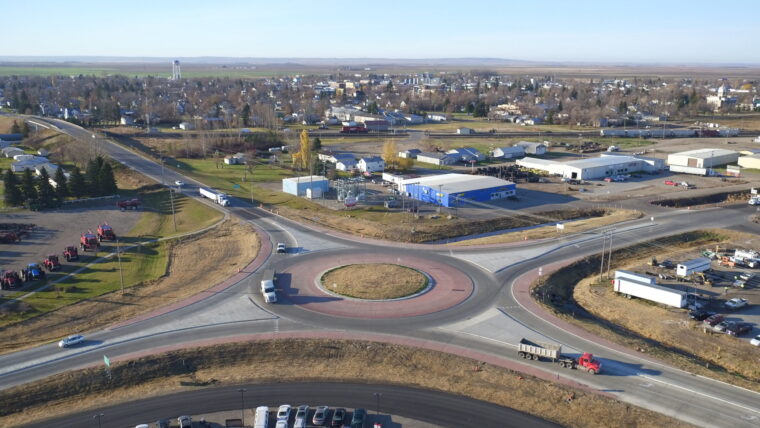
Roundabouts have significantly decreased serious injuries from vehicle crashes throughout North Dakota, according to a recently published study from the state’s Department of Transportation (NDDOT). The findings align with other nationwide studies on the effects of roundabouts on fatal and serious crashes.
According to the NDDOT report, severe injury and fatal crashes have decreased by 59%, and the total number of crashes has dropped by 33%. The study assessed the safety performance of roundabouts by comparing crash rates and severity before and after their completion. The analysis included data from 12 roundabouts within the state’s road network.
“Roundabouts are a proven counter-safety measure,” NDDOT Director Ron Henke said. “This data shows roundabouts are preforming well and saving lives in North Dakota.”
North Dakota’s first highway roundabout was built in 2012 on Highway 22 near Killdeer. Currently, there are 14 roundabouts in the state, with plans to install 13 more in the coming years.
Data from the Insurance Institute for Highway Safety (IIHS) concurs with the results seen in North Dakota’s study:
Studies of intersections converted from traffic signals or stop signs to roundabouts have found reductions in injury crashes of 72% to 80% and reductions in all crashes of 35% to 47%.
A study of 19 higher-speed rural intersections (speed limits of 40 mph or higher) that originally had stop signs on the minor approaches and were converted to roundabouts found a 62% reduction in all crashes and an 85% reduction in injury crashes.
Based on the results of a 2004 study, the conversion of 10% of the signalized intersections in the United States to roundabouts would have prevented approximately 51,000 crashes in 2018, including 231 fatal crashes and about 34,000 crashes involving injuries.
Despite the proven safety benefits of roundabouts, crashes still occur.
An IIHS study of 38 roundabouts in Maryland identified four main crash types: run-off-road, rear-end, sideswipe and entering-circulating, which accounted for nearly all incidents. A common crash involved vehicles hitting the central island, often due to unsafe speeds, making up almost half of single-vehicle run-off-road crashes, possibly because drivers didn’t see the roundabout in time to slow down.
Another review of 39 roundabouts in the U.S. found that entering, exiting and rear-end collisions were most common, with single-lane roundabouts mainly experiencing entering crashes and multi-lane roundabouts seeing more exiting crashes. Reviews of fatal crashes at roundabouts and injury crashes in Washington and Wisconsin showed an overrepresentation of motorcycle crashes, fixed-object crashes and crashes involving impaired driving.
The Washington State Department of Transportation cites three primary factors that contribute to roundabouts reducing the likelihood and severity of collisions:
Low travel speeds: Drivers must slow down and yield before entering a roundabout, with typical speeds between 15 and 20 miles per hour. Collisions that occur at these speeds are generally minor and result in few injuries.
No light to beat: Roundabouts allow a continuous flow of traffic, requiring drivers only to yield before entering. Without the need to stop if the roundabout is clear, drivers are not tempted to speed up to beat the light as they might at a signalized intersection.
One-way travel: The gently curved roads leading into roundabouts direct drivers to travel counterclockwise, eliminating the potential for “T-bone” and head-on collisions.
Photo courtesy of America’s Transportation Awards
The post Roundabouts significantly reduce serious-injury crashes, study shows appeared first on Government Market News.
